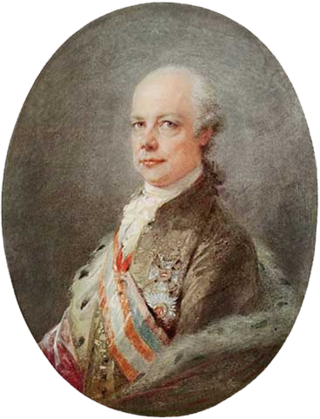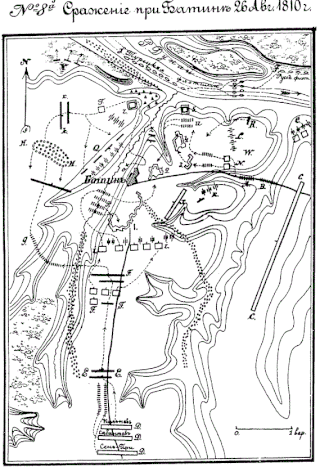
The Russo-Turkish War (1877–1878) was a conflict between the Ottoman Empire and a coalition led by the Russian Empire which included Romania, Serbia, and Montenegro. Additional factors included the Russian goals of recovering territorial losses endured during the Crimean War of 1853–1856, re-establishing itself in the Black Sea and supporting the political movement attempting to free Balkan nations from the Ottoman Empire. The Romanian army had around 114,000 soldiers in the war. In Romania the war is called the Russo-Romanian-Turkish War (1877–1878) or the Romanian War of Independence (1877–1878).

Oltenița is a city in Călărași County, Muntenia, Romania, on the left bank of the river Argeș, where its waters flow into the Danube.

The Russo-Turkish War (1806–1812) between the Russian Empire and the Ottoman Empire was one of the Russo-Turkish Wars. Russia prevailed, but both sides wanted peace as they feared Napoleon's moves to the east.

Zimnicea is a town in Teleorman County, Romania, a port on the Danube opposite the Bulgarian city of Svishtov.

The Romanian War of Independence is the name used in Romanian historiography to refer to the Russo-Turkish War (1877–78), following which Romania, fighting on the Russian side, gained independence from the Ottoman Empire. On April 16 [O.S. April 4] 1877, Romania and the Russian Empire signed a treaty at Bucharest under which Russian troops were allowed to pass through Romanian territory, with the condition that Russia respected the integrity of Romania. Consequently, the mobilization of the Romanian troops also began, and around 114,000 soldiers were massed in the south of the country to defend against an eventual attack of the Ottoman forces from south of the Danube. On April 24 [O.S. April 12] 1877, Russia declared war on the Ottoman Empire and its troops entered Romania through the newly built Eiffel Bridge, on their way to the Ottoman Empire. Due to great losses, the Russian Empire asked Romania to intervene. On July 24 [O.S. July 12] 1877, the first Romanian Army units crossed the Danube and joined forces with the Russian Army.

Svishtov is a town in northern Bulgaria, located in Veliko Tarnovo Province on the right bank of the Danube river opposite the Romanian town of Zimnicea. It is the administrative centre of the homonymous Svishtov Municipality. The town is the second-largest in the province after the city of Veliko Tarnovo and before Gorna Oryahovitsa.

The siege of Plevna or Pleven, was a major battle of the Russo-Turkish War of 1877–1878, fought by the joint army of Russian Empire and Kingdom of Romania against the Ottoman Empire. After the Russian army crossed the Danube at Svishtov, it began advancing towards the centre of modern Bulgaria, with the aim of crossing the Balkan Mountains to Constantinople, avoiding the fortified Turkish fortresses on the Black Sea coast. The Ottoman army led by Osman Pasha, returning from Serbia after a conflict with that country, was massed in the fortified city of Pleven, a city surrounded by numerous redoubts, located at an important road intersection.
Chronological listing of the Battles of the Russo-Turkish War (1877–1878).

The Battle of Nikopol, or Nicopolis, was one of the early battles of the Russo-Turkish War (1877–1878). As the Russian army crossed the Danube River, they approached the fortified city of Nikopol (Nicopolis). The Turkish high command sent Osman Pasha with the troops from Vidin to oppose the Russians' crossing of the Danube. Osman's intentions were to reinforce and defend Nikopol. However, the Russian IX Corps under General Nikolai Kridener reached the city and bombarded the garrison into submission before Osman could arrive. He instead fell back to Plevna. With the Nikopol garrison eliminated, the Russians were free to march on to Plevna.

Shipka Pass is a scenic mountain pass through the Balkan Mountains in Bulgaria. It marks the border between Stara Zagora province and Gabrovo province. The pass connects the towns of Gabrovo and Kazanlak. The pass is part of the Bulgarka Nature Park.
Tutrakan is a town in northeastern Bulgaria, an administrative centre of the homonymous municipality, part of Silistra Province. It is situated on the right bank of the Danube opposite the Romanian town of Oltenița, in the very west of Southern Dobruja, 58 km east of Rousse and 62 km west of Silistra.

The Battle of Svistov took place during the Russo-Turkish War of 1877–1878. It was fought between the Ottoman Empire and Imperial Russia on 26 June 1877. It occurred when Russian general Mikhail Ivanovich Dragomirov crossed the Danube River in a fleet of small boats and attacked the Turkish fortress. The next day, Mikhail Skobelev attacked, forcing the Turkish garrison to surrender. In result, the Russian military became ready to attack Nikopol.
![<i>Heroes of Shipka</i> 1955 [[Soviet Union]] film](https://upload.wikimedia.org/wikipedia/en/2/2d/Geroite_na_Shipka.jpg)
Geroite na Shipka is a 1955 Soviet Union/Bulgarian co-production historical drama film. It tells the story of the famous Battle of Shipka Pass during the Russo-Turkish War of 1877–78. The production companies behind the film are Boyana Film, Bulgar Film and Lenfilm.

The Austro-Turkish War, also known as the Habsburg–Ottoman War, was fought from 1788 to 1791, between the Habsburg monarchy and the Ottoman Empire. During the conflict, Habsburg armies succeeded in taking Belgrade (1789) and liberating much of central Serbia, also capturing several forts in the Pounje region of the Ottoman Bosnia. Much of those gains were lost in the later stages of the war, that ended by the Treaty of Sistova (1791), with minor territorial changes in favor of the Habsburg side. The war was fought concomitantly with the Russo-Turkish War (1787–1792).

The Treaty of Sistova ended the last Austro-Turkish war (1787–91). Brokered by Great Britain, Prussia and the Netherlands, it was signed in Sistova in Bulgaria on 4 August 1791. The treaty was written in French and Turkish.

Todor Todorov Topalov, better known under the pseudonym Filip Totyu, was a Bulgarian revolutionary of the Bulgarian National Revival period and the voivoda of an armed band of volunteers.

The Battle of Slobozia was fought between Russia and the Ottoman Empire as a part of the Napoleonic Wars during the Russo-Turkish War of 1806–1812. The primary battle occurred on the left bank of the Danube River near the small village of Slobozia in Wallachia. Four miles to the southeast on the right bank of the Danube was the Ottoman fortress at Rusçuk. The Russian investment of the Ottoman forces at Slobozia including the final battle lasted approximately two and half months from 28 August to 14 November 1811, ending when Russian Commander Mikhail Kutuzov ultimately accepted the surrender of the Ottoman forces commanded by Ahmed Pasha.

Geshov Dimitar Ivanov was a Bulgarian officer. During the First World War, he commanded in 1916–1918 the Bulgarian First Army on the Salonika front.
Events from the year 1829 in Russia

The Battle of Batin took place on 9 September 1810 near the small town of Batin, north Bulgaria during the Russo-Turkish War of 1806 to 1812. The conflict involved an attack by Russian forces on a defensive position held by a numerically stronger Ottoman force. The outcome was a Russian victory which enabled their ongoing Balkan campaign to proceed unhindered.











![<i>Heroes of Shipka</i> 1955 [[Soviet Union]] film](https://upload.wikimedia.org/wikipedia/en/2/2d/Geroite_na_Shipka.jpg)





